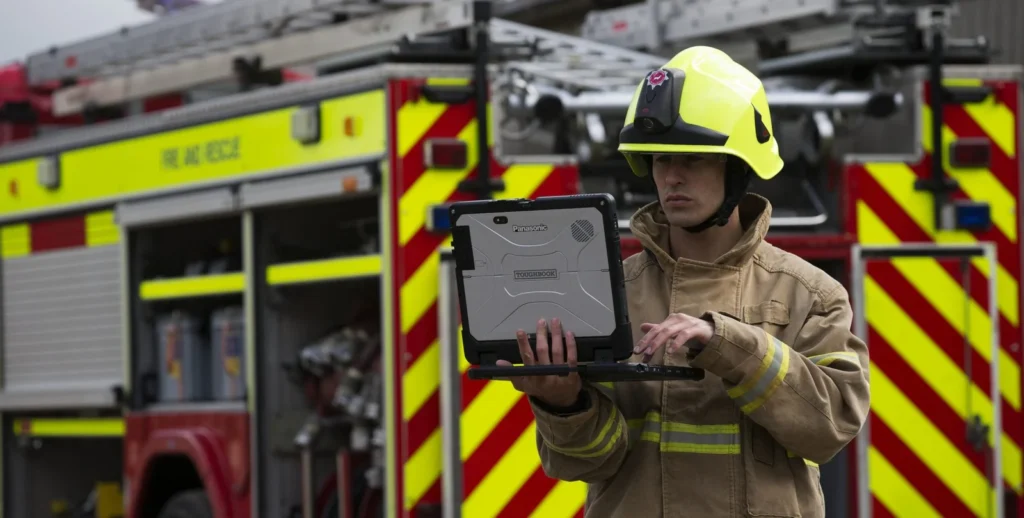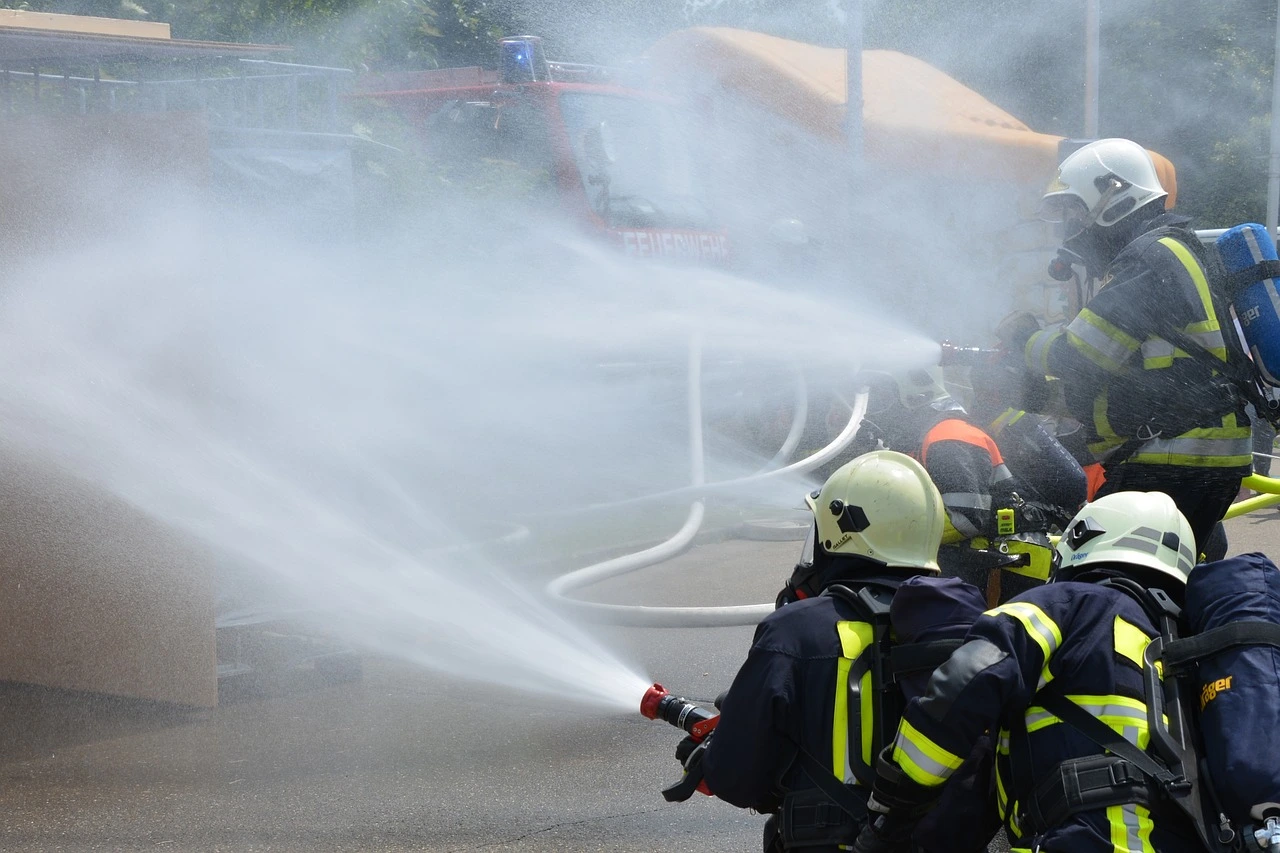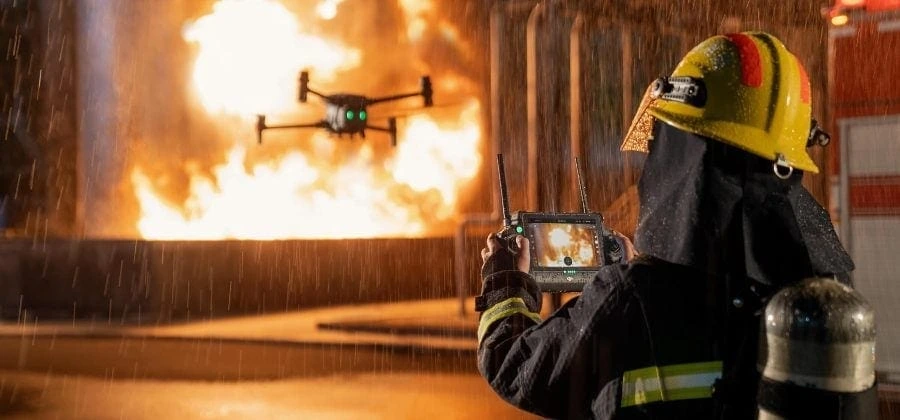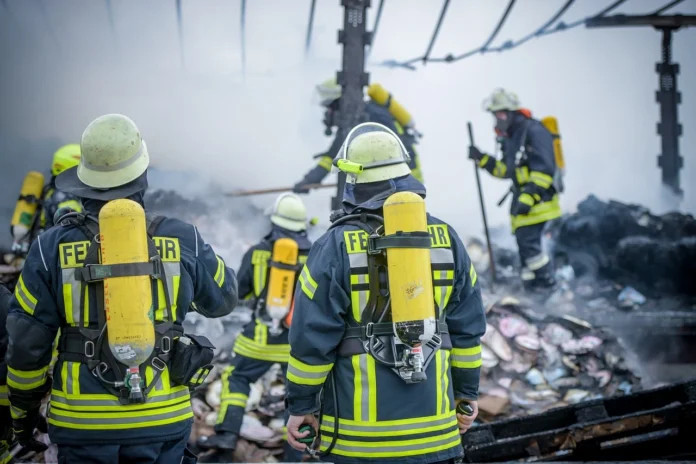In today’s rapidly evolving world, technology is critical in almost every industry, and firefighting is no exception. Fire departments increasingly rely on advanced tools and systems, so firefighters must stay up-to-date with technological advancements. Technology transforms firefighting training and operations, allowing more efficient, effective, and safer emergency response.
Modern firefighters must be well-versed in these innovations to perform their jobs, from high-tech equipment like drones and thermal imaging cameras to digital communication systems. Technology skills for firefighter training are no longer optional but essential for ensuring optimal safety, quick decision-making, and successful fire suppression and rescue efforts. This article explores the basic tech skills every firefighter should learn to excel in their training and ultimately enhance their operational capabilities.
Understanding Firefighting Technology Tools
Firefighting has advanced dramatically from traditional methods, and modern technology tools are now integral to ensuring more effective and safer operations. Firefighters today are equipped with various high-tech devices that enhance their ability to respond quickly, assess situations more accurately, and protect themselves and the public during emergencies.
- Drones: Drones are increasingly used in firefighting to provide real-time aerial footage of fire scenes. These uncrewed aerial vehicles (UAVs) can help firefighters assess the scale of the fire, identify hotspots, and locate victims or trapped individuals. Drones can also be used to survey hazardous areas that might be too dangerous for ground crews.
- Thermal Imaging Cameras: Thermal imaging cameras allow firefighters to see heat signatures through smoke, darkness, and walls. This tool helps identify the hottest parts of a fire, locate victims, and detect potential flare-ups in difficult-to-access areas. Mastering this technology enables firefighters to make quicker and safer decisions.
- Firefighting Drones and Robots: Robots equipped with fire suppression tools can be used in hazardous environments, such as those involving hazardous chemicals or high-risk rescues. These robots help firefighters control fires without exposing themselves to danger.
- Digital Communication Systems: Clear communication is vital during any emergency, and modern communication technology has vastly improved how fire departments relay information. Radios, GPS systems, and mobile apps provide real-time updates to crews and help coordinate operations in complex situations.
Improved technology tools for firefighter training are critical for enhancing the efficiency and safety of firefighting operations. Understanding how to operate these devices effectively can differentiate between a successful mission and a potentially disastrous outcome. Firefighters must be trained in using these technologies, ensuring they are well-prepared to utilize them during real-life emergencies.
Using Firefighting Apps and Software

In the digital age, firefighters can access various apps and software that help streamline operations, enhance communication, and improve training. These technologies transform how firefighters respond to emergencies, from real-time communication tools to advanced incident management systems.
Apps for Training and Real-Time Communication
Firefighting apps are now essential for both training and real-time coordination. These apps help recruits learn essential firefighting techniques through interactive simulations and training programs. Additionally, real-time communication apps enable seamless information exchange between firefighters in the field and their command center, ensuring the entire team stays connected and updated, improving response times and safety during operations.
Incident Management and Mapping Systems
Incident management software helps organize and coordinate firefighting efforts by enabling command centres to manage resources efficiently, track firefighter locations, and allocate equipment in real time. GPS-integrated mapping systems provide updated foreground layouts, allowing teams to track fire progression and make quicker, more informed decisions. This enhances efficiency and resource allocation, particularly during large or complex emergencies.
Examples of Popular Firefighting Apps and Platforms
- Firehouse Software: A widely used platform for incident reporting and management, allowing departments to track responses, resources, and outcomes.
- iTruckers: This app helps firefighters with route planning and real-time GPS tracking to avoid roadblocks and reach the fire scene faster.
- Firescope: A comprehensive software for tracking resources, managing incident command, and mapping firegrounds.
- Responder 360: An app that provides firefighters with real-time updates, alerts, and mapping during emergency operations.
Developing these technology skills for firefighter training ensures that firefighters can use these apps and software tools to improve their efficiency and safety on the job. Whether managing an incident, navigating fairgrounds, or communicating with the team, these digital platforms are becoming indispensable in modern firefighting operations.
Digital Fire Safety Systems
As fire fighting continues evolving with technological advancements, digital fire safety systems play an increasingly vital role in preventing fires and enhancing the safety of buildings and firefighters. These systems range from intelligent fire alarm networks to integrated building technologies designed to detect and manage fire risks. Understanding and utilizing these systems is essential to modern firefighters’ training and effectiveness.
Fire Alarm Systems
Modern fire alarm systems are not just limited to traditional bells or sirens; they now include advanced smoke and heat detectors, automated alerts, and real-time notifications to emergency services. These systems are often connected to local fire departments, allowing for faster emergency response times. Firefighters need to understand how these alarms work, their triggers, and how to integrate them into their strategies when responding to a fire.
Smart Buildings and IoT Integration
Smart buildings are equipped with Internet of Things (IoT) sensors that provide real-time data on a building’s environment. These systems include smoke detectors, heat sensors, and carbon monoxide monitors, which communicate with each other to create a comprehensive safety network. In case of a fire, these buildings can adjust fire dampers, lock or unlock doors, and guide evacuations automatically.
Fire Prevention Technology
In addition to detection, fire prevention technologies are becoming more sophisticated. Fire suppression systems like sprinklers, automated fire extinguishers, and even fire-resistant materials are increasingly being incorporated into building designs. Understanding how these technologies function is crucial for firefighters during their training, as it allows them to assess a building’s fire risk and respond appropriately quickly.
Firefighters may improve their reaction times, firefighters can better anticipate threats, optimize their response times, and ensure the safety of the public and themselves. Knowledge of fire alarm systems, innovative building technology, and fire prevention tools ensures that firefighters are equipped to handle modern challenges in fire safety.
Thermal Imaging and Data Analysis for Firefighters

Thermal imaging technology enhances firefighting by allowing firefighters to see through smoke and darkness, improving rescue efforts and safety.
Role of Thermal Imaging Cameras
Thermal imaging cameras (TICs) detect heat and create images based on temperature differences. They help identify fire hotspots, locate victims, and assess building integrity in low-visibility conditions.
Locating Victims and Hotspots
Thermal imaging identifies victims and hotspots by detecting heat signatures, even in smoke-filled environments. It helps firefighters focus on the most critical areas, improving rescue efficiency.
Interpreting Thermal Imaging Data
Thermal imaging cameras use color to indicate temperature ranges. Firefighters must understand these variations to assess fire intensity and decide where to focus their efforts.
Data Analysis and Decision-Making
Thermal cameras provide additional data, such as temperature readings, to help make real-time decisions. Proper data interpretation can significantly impact the outcome of a rescue or firefighting operation.
Communication Technology for Firefighters
Effective communication is essential for firefighting operations. As technology evolves, firefighters must learn modern communication tools to stay connected and respond efficiently.
Radios and Two-Way Communication
Advanced digital radios offer more transparent sound and better coverage. Firefighters must be trained to use these radios to relay important information during emergencies.
Satellite Communication
Satellite systems provide backup communication in remote areas or when regular networks fail. This training ensures firefighters stay connected, even in challenging environments.
Digital Dispatch Systems
These systems deliver real-time information, such as maps and incident data. Firefighters must learn to use these tools to improve their situational awareness and preparation.
Mobile Communication Apps
Smartphone apps allow for real-time updates, mapping, and data sharing. Firefighters must know how to use these apps to improve coordination during operations.
Cybersecurity Awareness for Firefighters
As firefighting technology evolves, so does the need to safeguard the sensitive data and systems that support emergency operations. Cybersecurity Awareness for Firefighters is increasingly becoming critical to modern firefighter training. Protecting sensitive information from digital communication systems to fire management software is essential for ensuring safety, privacy, and operational efficiency.
Securing Firefighting Data
Firefighting departments utilize digital tools to oversee their operations and monitor incidents, which frequently include sensitive information such as personal data, emergency plans, and building blueprints. A cyberattack or data breach can hinder operations, damage public trust, and endanger safety during emergencies. It’s essential for firefighters to recognize the significance of cybersecurity in safeguarding this vital information from possible threats.
Secure Digital Practices Training
Firefighters must be trained to follow secure digital practices and adhere to data protection protocols to mitigate risks. Here are key areas of cybersecurity training for firefighters:
- Password Management
Firefighters should be trained to create strong, complex passwords for their accounts and systems. They should also use password managers to securely store these passwords and avoid reusing them across different platforms.
- Recognizing Phishing Attacks
Training should focus on identifying phishing emails, fake websites, and other social engineering tactics. Firefighters must know how to handle suspicious communications to protect sensitive information from being compromised.
- Encryption and Data Storage
Firefighters must understand encryption to protect data both in transit and at rest. Training should ensure they are familiar with encryption technologies that secure communication platforms and digital systems.
- Safe Use of Mobile Devices
Training should emphasize the safe use of smartphones and tablets commonly used during firefighting operations. Firefighters should know how to lock devices, avoid untrusted networks, and use secure communication channels to protect sensitive data.
- Regular Software Updates
Firefighters should be trained to update their software regularly to prevent vulnerabilities. Keeping systems updated with the latest patches ensures that devices remain secure against known cyber threats.
- Incident Reporting and Response
Firefighters need to understand how to report cybersecurity incidents and breaches. Training should include the department’s protocols for escalating and responding to cyber threats to prevent further damage and ensure quick resolution.
Cybersecurity Culture in Firefighting Departments
Creating a cybersecurity-aware culture in firefighting departments is essential to protect digital systems. This includes regular training, emphasizing cybersecurity in daily operations, and ensuring every firefighter knows how to identify and manage potential threats. Cybersecurity should be integrated into firefighting strategies, ensuring all tech tools like communication systems, fire management software, and training platforms remain secure.
Legal and Ethical Considerations
Firefighters should be educated on the legal and ethical implications of cybersecurity breaches. Understanding the consequences of mishandling sensitive data and complying with privacy laws, like HIPAA and GDPR, when managing personal information during emergency responses is essential. This ensures both legal protection and ethical responsibility in their operations.
Building Resilience to Cyber Threats
Fire departments should prioritize the development of incident response plans that incorporate cybersecurity measures. By preparing for cyber threats as part of their overall emergency response, firefighters will be better equipped to handle digital security challenges that may arise during operations. Continuous training and updates on new cybersecurity threats are key to maintaining a resilient workforce capable of handling physical and cyber emergencies.
Robotics and Drones in Firefighting

Drones in Firefighting
Drones are increasingly being used in firefighting for aerial views during missions. They provide real-time video footage, enabling commanders to assess fire spread, locate victims, and determine safe routes for firefighters.
Robotics for Search and Rescue
Robots are used for search and rescue operations in hazardous environments, such as collapsed buildings or high-risk areas. They can navigate dangerous spaces to locate survivors while minimizing firefighter risk exposure.
Technology Integration in Emergency Medical Response (EMS)
Tech in EMS Operations
Technology in EMS helps track patients in real-time and store digital health records. It enhances communication between EMS teams and hospitals, ensuring faster treatment and more accurate patient information.
Integrating Tech into Firefighter Training
Firefighter training now incorporates EMS-related technologies, preparing firefighters for medical emergencies. Training on patient tracking systems and digital medical records ensures responders can effectively manage medical crises during firefighting operations.
Continuous Learning Through Online Training Platforms
Continuous Learning Through Online Training Platforms has become essential to firefighter training in today’s rapidly evolving technological landscape. As firefighting techniques and technologies advance, firefighters must stay informed and up-to-date on the latest tools, strategies, and procedures to ensure they are prepared for emergencies. Online training platforms play a significant role in fostering continuous learning and professional growth for firefighters.
1. UE-learning Platforms for Firefighter Training
E-learning platforms offer flexible, accessible, and interactive training opportunities for firefighters. These platforms can be accessed from anywhere, allowing firefighters to participate in training sessions, webinars, and certification programs without the need for physical attendance at training centers. This is particularly beneficial for busy fire departments with varying shift schedules, enabling firefighters to learn at their own pace and according to their availability.
Key features of e-learning platforms for firefighters include:
- Interactive Modules: Many online platforms provide interactive courses that simulate real-life firefighting scenarios. These modules can include video tutorials, quizzes, and practical demonstrations to enhance learning and understanding.
- Virtual Simulations: Advanced e-learning platforms offer virtual reality (VR) and augmented reality (AR) simulations that mimic real-world firefighting situations. This allows firefighters to practice their skills in a controlled, safe, and virtual environment without the risk of injury.
- Certifications and Recertifications: E-learning platforms often offer certification programs and recertification opportunities for specialized firefighting skills, ensuring that firefighters meet the required standards and maintain their credentials over time.
- On-Demand Access: With the flexibility to access courses and training materials anytime, firefighters can quickly refresh their knowledge or learn new skills without waiting for in-person classes or training events.
2. Staying Updated with Firefighting Tech
As firefighting technology advances, firefighters must remain informed about the latest tools, gadgets, and techniques available to enhance their effectiveness in emergencies. The continuous development of new technologies such as drones, thermal imaging cameras, fire simulation software, and AI-based incident management systems requires firefighters to adapt and learn how to use them efficiently.
By participating in online training courses, firefighters can:
- Stay Updated on Cutting-Edge Technology: Online platforms frequently update their courses to reflect the latest advancements in firefighting technology. This ensures firefighters stay informed about new tools and systems that enhance safety and effectiveness.
- Enhance Technical Skills: Mastering technology like drones for aerial surveillance, thermal imaging devices, and incident management software can improve response times and operational outcomes.
- Promote Adaptability: Online training ensures firefighters remain adaptable to evolving technologies, helping them effectively use new tools and systems integrated into firefighting operations.
- Improve Safety and Response Times: Training in modern technology empowers firefighters to make better decisions quickly, aiding in victim location, fire mapping, and real-time communication, which can save lives and protect property.
3. The Role of Online Communities and Peer Learning
In addition to formal e-learning platforms, online communities and forums for firefighters provide valuable peer learning opportunities. Firefighters can share experiences, discuss challenges, and exchange tips on using new technology in real-world scenarios. These communities create a collaborative learning environment that fosters the sharing of best practices and lessons learned.
4. Personalizing the Learning Experience
E-learning platforms often allow for personalized learning paths, enabling firefighters to focus on the areas where they need the most improvement. Whether mastering a new technology or brushing up on specific firefighting techniques, these platforms provide the flexibility to tailor the training experience to each firefighter’s needs.
5. Cost-Effective and Time-Efficient Training
Online training platforms offer a cost-effective alternative to traditional, in-person training programs. They eliminate travel costs and time away from the station, enabling firefighters to complete courses during downtime. This ensures that training remains a priority without disrupting daily operations.
Summary
In conclusion, embracing technology is no longer a choice but a necessity for modern firefighters. From understanding the intricacies of drones and thermal imaging cameras to mastering digital communication systems, incident management software, and cybersecurity protocols, technology skills for firefighter training are paramount. This comprehensive overview has highlighted the importance of these skills across various facets of firefighting, including operations, training, fire safety systems, data analysis, communication, cybersecurity, robotics, EMS integration, and continuous learning.
By investing in comprehensive technology training, fire departments empower their personnel to respond more effectively, efficiently, and safely to emergencies. This commitment to continuous learning and adaptation ensures that firefighters remain at the forefront of their field, equipped to handle the ever-evolving challenges of modern firefighting and ultimately better serve their communities.



